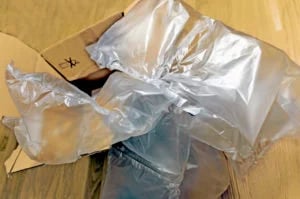
Avoid the void. That’s the byword for anyone who ships products that might be damaged in transit.
And the solution, at least for companies like Amazon, is air cushion (or air pillow) packaging.
Why Choose Air Cushion Packaging?
Air cushion packaging is exactly what it sounds like. Think whoopee cushion without the sound effects (or the air leak). It’s an air-filled pillow made of biodegradable or HDPE (recyclable) film.
Well on its way to replacing packing peanuts and other methods for filling voids and providing protection from bumps and jostling, air cushion packaging is:
- Less space-greedy in the warehouse. Air cushions are inflated and sealed when they’re needed.
- Better for the environment. Air cushions are often recyclable and reusable.
- Better protection. The cushions can hold the product in place while shielding it from blows to a box’s sides.
- Versatile. Air cushions can also be custom made, and they work well with other kinds of packaging.
- Not abrasive. The cushions can be used with items that might otherwise be subject to scratching.
- Easy to use. Air cushions come in a wide variety of sizes to make finding the right cushion for the application simple.
The Cost of Damaged Products:
Damage during shipping is costly. For example, UPS and FedEx ship about 8 billion packages a year. About 1% of them end up lost or damaged.
Doesn’t sound like much until the realization hits that 1% of 8 billion is 8 million. A significant portion of that damage results from parcels getting thrown, dropped and/or compressed by poor stacking.
The cost of damage during shipping doesn’t stop with the product itself, which has to be replaced. There’s more:
- Return shipping costs
- Labor to send the package again
- Cost of new packaging
- Outbound shipping costs
Multiply these costs by a few hundred or a few thousand damaged products, and it can add up to a blow to the bottom line.
When to Use Air Cushions:
Of course, not every packaging challenge calls for air cushions. They probably won’t show up in a box with clothes or doggy chew toys.
But they will likely be found filling the voids and protecting things like:
- Cellular phones
- Laptop computers
- Video game consoles
- Blu-ray players
- Glass and ceramic products
- Other small, fragile items
Air cushion packaging isn’t recommended for larger or heavier products, such as televisions or items with sharp corners or edges. They can pop, puncture or cut the film and deflate the pillow.
Is Air Cushion Packaging the Right Choice For Your Products?
Anyone using bubble wrap or packing peanuts to ship smaller, lighter items that might be damaged if the box carrying them is dropped, thrown or compressed should consider using air cushion packaging. Savings on the cost of replacing and re-shipping products can be substantial.
Air cushion packaging is an investment in protection that can pay significant dividends not only in cost-savings but also customer satisfaction.
.png?width=845&height=137&name=Slice%203%20(23).png)
